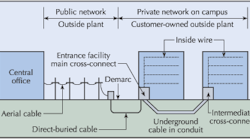This article kicks off EC&M’s yearlong coverage of how cabling contractors can generate new business in customer-owned outside plant (CO-OSP) design work.
Although outside-plant (OSP) work has been around for a long time, it is foreign territory to most cabling contractors. This is not surprising when you consider that all OSP infrastructure fell under the jurisdiction of the Bell telephone public network for decades. However, with the divestiture of the Bell system in the mid-1980s, this situation changed drastically. Suddenly, the cabling infrastructure on a customer's premises (buildings and grounds) became private property. Thus, customer-owned outside plant (CO-OSP) was born.
However, for a decade following the Bell breakup, CO-OSP was in limbo: It was no longer part of the public network, yet the premises cabling community didn't recognize it. Two recent events changed this. The first was the publication of ANSI/TIA/EIA 758, Customer-Owned Outside Plant Telecommunications Cabling Standard, which was developed by the Telecommunications Industry Association (TIA) and “provides the requirements used in the design of telecommunications pathways and spaces, and the cabling installed between buildings or points in a customer-owned campus environment.” The second was the recognition by BICSI of CO-OSP as a subspecialty for cabling infrastructure designers. Today, this niche is an important subspecialty for cabling installations on military facilities, industrial complexes, business parks, shopping malls, health-care facilities, prisons, schools, colleges, and universities.
Why is CO-OSP work important for cabling contractors? Understanding how it fits into the overall scheme of a project gives them an opportunity to gain more business from this specialized subcontract work. That's why EC&M has committed to a yearlong series on how high-tech contractors can become OSP experts and generate new streams of revenue.
To help you learn more about CO-OSP, EC&M will cover one chapter of the Second Edition of the Customer-Owned Outside Plant Design Manual (published by BICSI and available in hard copy and CD-ROM versions) each month this year, followed by a summary and a discussion of your questions and comments in the December 2002 issue. Why is this manual so important? In conjunction with publication of the technical manual, BICSI designed a training course for those who wish to specialize in this type of work. Holders of BICSI's Registered Communications Distribution Designer (RCDD) designation have recently been able to take this course, study the manual, and take an exam. Those who pass the exam receive a CO-OSP specialist designation, much like BICSI's earlier LAN specialist designation. Any contractors interested in earning CO-OSP accreditation through BICSI should contact the organization directly.
Chapter 1 of the manual presents an overview of the CO-OSP network, including a section on the purpose of U.S. codes and standards. It begins by defining outside plant as all of the cabling infrastructure between the central office of the telephone company or the head end of the cable provider and the customer's premises (Fig. 1, above, top). Generally, OSP is broken down into three types of cabling: aerial, direct-buried, and underground. Aerial OSP cabling is what we've all seen on utility poles. In densely populated urban areas, it is common for some, if not all, of the OSP infrastructure to run underground. If the cable is buried in the soil without protection, it's called direct-buried OSP cable; if it runs in conduit or a tunnel, it's considered underground OSP cable. The point at the edge of a customer's property is called the demarcation point, or demarc, for short. The changeover between the access provider's cabling infrastructure and the customer's usually takes place at a nearby site called the entrance facility.
Chapter 1 also covers other topics, including a listing of CO-OSP planning functions, work prints and specifications, right-of-way, pathways and spaces, OSP cabling, and air-pressure systems. Readers exploring CO-OSP for the first time will find the illustration of its components helpful (Fig. 2 above).
Next month, we will review Chapter 2, which details CO-OSP infrastructure.
Powell is an editorial consultant to EC&M. Please send questions or comments to [email protected].
Looking Ahead…
Throughout 2002, Powell will address the remaining 10 chapters in BICSI's CO-OSP second edition manual, which includes a discussion of the following topics:
-
Chap. 2 — CO-OSP Infrastructure, which covers cable types and placement.
-
Chap. 3 — Pathways and Spaces, covering underground, direct-buried, and aerial pathways.
-
Chap. 4 — Cabling, which covers optical fiber, twisted-pair cabling, and splicing.
-
Chap. 5 — Cabling Hardware, including hardware selection and labeling.
-
Chap. 6 — Grounding, Bonding, and Electrical Protection, covering bonding requirements, protectors, and lightning protection.
-
Chap. 7 — Air Pressure Systems, covering feed pipe and dryers.
-
Chap. 8 — Rights-of-Way, including methods of describing property.
-
Chap. 9 — Design Documentation, which includes work print specifications.
-
Chap. 10 — Scope of Work, including material list and final acceptance.
-
Chap. 11 — Project Management, including project schedules and tracking.





